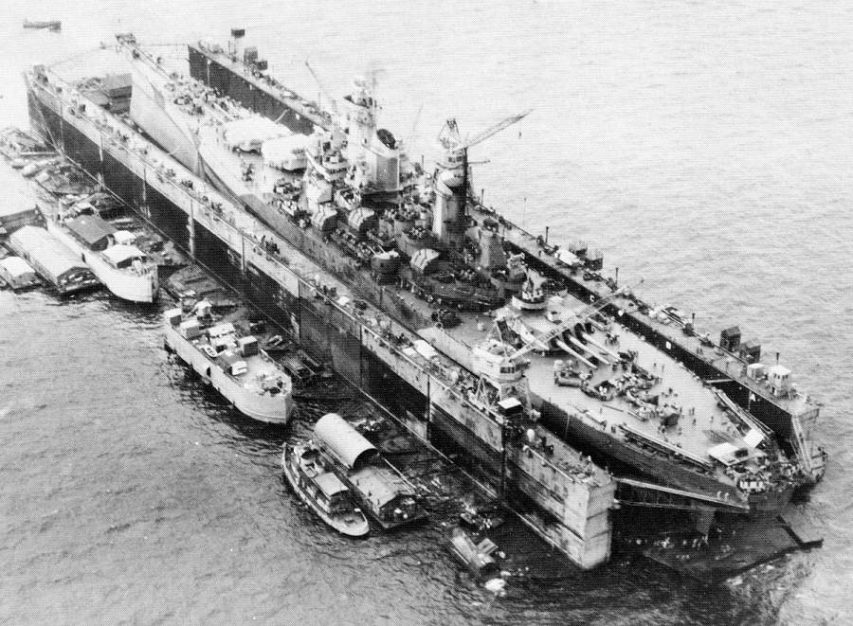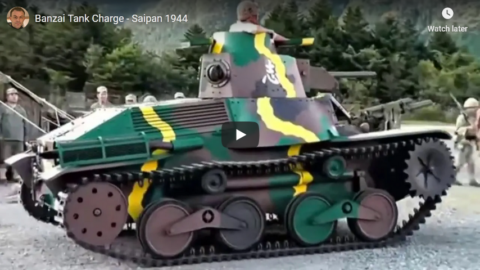World War Two
Published 27 Oct 2023When Marine Corps General Holland “Howling Mad” Smith removed Infantry General Ralph Smith from command in 1944 during the Battle of Saipan, it began a controversy that soon snowballed, threatening to sabotage Army-Marine relations at a time when cooperation was the key to victory.
(more…)
October 28, 2023
Smith versus Smith: US Army/Marine relations in 1944
July 16, 2023
Mass Suicide on Saipan – WW2 – Week 255 – July 15, 1944
World War Two
Published 15 Jul 2023Japanese troops and civilians commit mass suicide rather than surrender to the Americans in the Marianas; in Normandy, Caen has finally fallen to the Allies though the fight for St. Lo is not over; the Soviet offensives in the north take Vilnius and the fighting continues up in Finland, but the big eastern front news is the mighty new Soviet offensive in Western Ukraine. (more…)
July 9, 2023
The Destruction of Army Group Center – Week 254 – July 8, 1944
World War Two
Published 8 Jul 2023Operation Bagration continues, smashing the armies of German Army Group Center and taking ever more territory including the prize of Minsk; on Saipan the Americans have taken most of the island when the Japanese resort to a huge suicidal banzai charge to try and turn the tide; and in Normandy new attacks begin try to finally take Caen and St. Lo.
(more…)
July 2, 2023
Allies Liberate Cherbourg – WW2 – Week 253 – July 1, 1944
World War Two
Published 1 Jul 2023Several weeks after the invasion of Normandy began, the Allies finally take a port city there, though the actual harbor has been destroyed. On Saipan the Americans have the advantage, in Finland, the Soviets do, but the big news is the Soviet destruction of huge chunks of German Army Group Center, demolishing entire Army Corps, and surrounding tens of thousands of the enemy.
(more…)
June 25, 2023
The Greatest Pincer Movement in Military History – WW2 – Week 252 – June 24, 1944
World War Two
Published 24 Jun 2023The Red Army surges forward in Operation Bagration, a mighty new offensive to destroy German Army Group Centre. Fighting continues in Normandy, Italy, and Finland. The United States Navy tears the heart out of the Imperial Japanese Navy in the Philippine Sea even as the Imperial Japanese Army has success in China. The British and Indian armies lift the siege of Kohima.
(more…)
June 18, 2023
Titanic Clash Looms In Pacific – WW2 – Week 251 – June 17, 1944
World War Two
Published 17 Jun 2023Japanese and American navies are heading for a showdown in the Philippine Sea, even as American forces land on Saipan in the Marianas in force. The Japanese have Changsha under siege in China, the Allies advance in both Normandy and Italy, the Soviets advance in Finland, and the massive Soviet summer operation is coming together and will begin in a matter of days.
(more…)
January 7, 2021
Banzai Tank Charge – Saipan 1944
Mark Felton Productions
Published 6 Jan 2020The story of the largest tank battle of the Pacific Campaign on the island of Saipan.
Dr. Mark Felton is a well-known British historian, the author of 22 non-fiction books, including bestsellers Zero Night and Castle of the Eagles, both currently being developed into movies in Hollywood. In addition to writing, Mark also appears regularly in television documentaries around the world, including on The History Channel, Netflix, National Geographic, Quest, American Heroes Channel and RMC Decouverte. His books have formed the background to several TV and radio documentaries. More information about Mark can be found at: https://en.wikipedia.org/wiki/Mark_Fe…
Visit my audio book channel “War Stories with Mark Felton”: https://youtu.be/xszsAzbHcPE
Help support my channel:
https://www.paypal.me/markfeltonprodu…
https://www.patreon.com/markfeltonpro…Disclaimer: All opinions and comments expressed in the ‘Comments’ section do not reflect the opinions of Mark Felton Productions. All opinions and comments should contribute to the dialogue. Mark Felton Productions does not condone written attacks, insults, racism, sexism, extremism, violence or otherwise questionable comments or material in the ‘Comments’ section, and reserves the right to delete any comment violating this rule or to block any poster from the channel.
September 15, 2018
Battle of Saipan – Suicide Island – Extra History – #2
Extra Credits
Published on 13 Sep 2018This series is brought to you by World of Tanks PC. Check out the game at the link below and use the invite code FORAGER for extra goodies. https://redir.wargaming.net/r06pve1j/…
As the ruthless clash of the Saipan invasion drags on into the second week, a unique and unlikely hero emerges. Marine scout Guy Gabaldon can speak Japanese. He deserts his post, not once but twice, to reach out to the enemy soldiers and civilians.
September 8, 2018
Battle of Saipan – Steel and Coral – Extra History – #1
Extra Credits
Published on 6 Sep 2018The battle of Saipan would decide the fate of the Pacific War. On a tiny island, just five miles wide, thousands died under advanced artillery and amphibious tanks. This series is brought to you by World of Tanks PC. Check out the game at the link below and use the invite code FORAGER for extra goodies. https://redir.wargaming.net/r06pve1j/…
Support us on Patreon! http://bit.ly/EHPatreon
July 2, 2017
The US Navy’s WW2 floating drydocks
I’d never heard of these massive mobile drydock facilities before:

USS Iowa (BB-61) in a floating drydock at Manus Island, Admirality Islands, 28 December 1944. (via Wikimedia)
The United States Navy, during World War 2, decided to create a temporary forward base utilizing service stations; these stations meant the United States Navy could operate throughout the huge Pacific Ocean for more sustained amounts of time.
Creating these pretty much meant they could have a major naval base within a short distance of any operation carried out in the area. The base was able to repair; resupply and refit, meaning fewer ships had to make the journey to a facility at a major port, which allowed them to remain in the Pacific for up to a year and beyond.
These stations were officially named Advance Base Sectional Docks (ABSDs) and were put together section by section. Each part was welded to the next once in their correct position.
There were two different sizes of floating docks created, the largest ones were created using ten sections and could lift 10,000 tons each – being 80 feet wide and 256 feet long. Once these sections were welded together, it became a fully assembled dock that was a whopping 133 feet wide, 827 feet long and could lift up to 90,000 tons.
This was more than enough lifting power for any ship within the Fleet.
The post also included this film, showing the USS Idaho being moved into an ABSD at Esperitu Santo in August, 1944:
Published on 7 May 2015
On August 15, 1944 the mighty battleship Idaho arrived at Espiritu Santo in the Pacific and slipped into a floating dry dock so that emergency repairs could be made to the ship’s blisters. This special film — likely made by the crew of the battleship’s observation aircraft — documents the activities as the ship is maneuvered into position. The dry dock shown is likely one of the Large Auxiliary Floating Dry Docks (AFDB), probably AFDB/ABSD-1. This was constructed in sections during 1942 and 1943 at Everett Shipbuilding Co., Everett, WA., by the Chicago Bridge & Iron Co., Eureka, CA., the Pollack-Stockton Shipbuilding Co., Stockton, CA., and Chicago Bridge & Iron Co., Morgan City, LA. During World War II ABSD-1 was assigned to the Asiatic-Pacific Theater and towed to Espiritu Santo in the New Hebrides and assembled for service. Later it was disassembled and towed to Manicani Bay, P.I. and reassembled for service by September 1945.
USS Idaho had been damaged during long days of combat that began with the bombardment of Saipan in June. With the landing assault underway on 15 June, the battleship moved to Guam for bombardment assignments. As the American fleet destroyed Japanese carrier air power in the Battle of the Philippine Sea from 19–21 June, Idaho protected the precious transport area and reserve convoys. After returning to Eniwetok from 28 June to 9 July, the ship began preinvasion bombardment of Guam on 12 July, and continued the devastating shelling until the main assault eight days later. As ground troops battled for the island, Idaho stood offshore providing vital support until anchoring at Eniwetok on 2 August.
After repair, Idaho‘s mighty guns were needed for the next giant amphibious assault on the way to Japan. She sailed from San Diego on 20 January 1945 to join a battleship group at Pearl Harbor. After rehearsals, she steamed from the Marianas on 14 February for the invasion of Iwo Jima. As Marines stormed ashore on 19 February, Idaho was again blasting enemy positions with her big guns, and fired star shells at night to illuminate the battlefield. She remained off Iwo Jima until 7 March, when she underway for Ulithi and the last of the great Pacific assaults – Okinawa.
At the end of the conflict Idaho made her triumphal entry into Tokyo Bay with occupation troops on 27 August, and was anchored there during the signing of the surrender on board the Missouri on 2 September. Four days later she began the long voyage to the East Coast of the United States, steaming via the Panama Canal to arrive at Norfolk on 16 October. She decommissioned on 3 July 1946 and was placed in reserve until sold for scrap on 24 November 1947 to Lipsett, Incorporated, of New York City.




